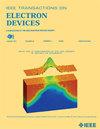Efficient Large Scale Neural Network Acceleration With 3-D FeNOR-Based Computing-in-Memory Design
IF 2.9
2区 工程技术
Q2 ENGINEERING, ELECTRICAL & ELECTRONIC
引用次数: 0
Abstract
In this work, we introduce and experimentally demonstrate a 3-D stacked ferroelectric基于三维fenor内存计算设计的高效大规模神经网络加速
在这项工作中,我们介绍并实验展示了一种3-D堆叠铁电nor (FeNOR)存储器,具有后端线(BEOL)氧化锌(ZnO)通道和金属-铁电-金属-绝缘体半导体(MFMIS)单元电池。本工作的主要贡献如下:1)增强的记忆窗口(MW)和高开/关比:三维FeNOR中的MFMIS架构实现了可调的大MW (~4 V),以及6个数量级的开/关比(${I}_{\text {on}}$ / ${I}_{\text {off}}$);2)低工作电压和高耐用性:铁电材料的集成允许低工作电压(~4 V)和优异的耐用性($10^{{7}}$循环);3)高效的神经网络实现:利用3- d FeNOR结构,我们进一步开发了VGG-16和ResNet-50卷积神经网络,实现了高预测精度、良好的面积效率和低功耗。3-D FeNOR技术的出现使铁电器件成为内存计算(CIM)应用的一个非常有前途的候选器件。
本文章由计算机程序翻译,如有差异,请以英文原文为准。
求助全文
约1分钟内获得全文
求助全文
来源期刊

IEEE Transactions on Electron Devices
工程技术-工程:电子与电气
CiteScore
5.80
自引率
16.10%
发文量
937
审稿时长
3.8 months
期刊介绍:
IEEE Transactions on Electron Devices publishes original and significant contributions relating to the theory, modeling, design, performance and reliability of electron and ion integrated circuit devices and interconnects, involving insulators, metals, organic materials, micro-plasmas, semiconductors, quantum-effect structures, vacuum devices, and emerging materials with applications in bioelectronics, biomedical electronics, computation, communications, displays, microelectromechanics, imaging, micro-actuators, nanoelectronics, optoelectronics, photovoltaics, power ICs and micro-sensors. Tutorial and review papers on these subjects are also published and occasional special issues appear to present a collection of papers which treat particular areas in more depth and breadth.
 求助内容:
求助内容: 应助结果提醒方式:
应助结果提醒方式:


